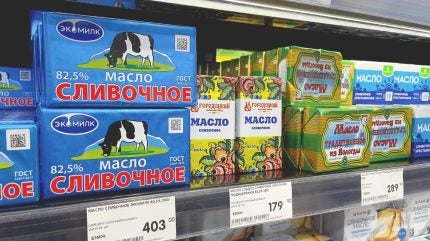
The Russian dairy industry has faced profound challenges in recent years, particularly in the packaging sector. The imposition of western sanctions since 2022 disrupted supply chains and restricted access to essential materials and machinery.
However, the country’s response has been swift and adaptive, with the packaging sector undergoing a remarkable transformation.

Discover B2B Marketing That Performs
Combine business intelligence and editorial excellence to reach engaged professionals across 36 leading media platforms.
From initial shortages to near-complete localisation, Russia’s experience offers insight into how industries can navigate geopolitical pressures while maintaining production.
This article explores the journey of dairy packaging in Russia, focusing on the impact of sanctions, the strategies employed to overcome shortages, and the current state of the industry as it balances resilience with ongoing challenges.
The impact of western sanctions on Russian dairy packaging
Western sanctions, implemented in response to geopolitical tensions, have had a significant effect on Russia’s supply chains, especially in industries reliant on imported raw materials and equipment.
The dairy packaging sector was particularly vulnerable due to its dependence on specialised components such as laminated cartonboard, polymer films, inks, adhesives, and aseptic packaging technology—much of which was sourced from Europe and other western countries.

US Tariffs are shifting - will you react or anticipate?
Don’t let policy changes catch you off guard. Stay proactive with real-time data and expert analysis.
By GlobalDataBefore the sanctions, approximately half of Russia’s dairy packaging materials, including aseptic cartons commonly used for milk and juice, were imported. These materials are critical for preserving shelf life, maintaining product safety, and meeting consumer expectations.
The sudden restriction on imports led to acute shortages, forcing dairy producers to confront the risk of interrupted production and distribution.
Moreover, the packaging machinery itself, such as filling lines and sealing equipment, often required maintenance parts and technical support from western manufacturers.
The sanctions complicated access to spare parts and technical expertise, increasing downtime and reducing efficiency.
Consequently, many smaller converters and packaging suppliers faced financial strain, while larger companies were compelled to seek alternatives quickly.
Strategies for overcoming packaging shortages and localisation efforts
Faced with these constraints, the Russian dairy packaging sector embarked on a rapid import substitution and localisation drive.
Government agencies, industry associations, and private enterprises collaborated to stabilise supply and support domestic production. This multi-pronged approach included several key strategies:
- Development of domestic materials: Russian manufacturers accelerated the production of laminated cartonboard and polymer films that could meet food safety and durability standards. Investments were made to enhance coating technologies, printing inks, and adhesives compatible with dairy products.
- Sourcing from alternative markets: Companies expanded procurement beyond traditional western suppliers to include countries less affected by sanctions, such as China, Turkey, India, and the United Arab Emirates. This diversification helped alleviate immediate shortages while domestic production capacity was scaled up.
- Stockpiling and inventory management: Dairy producers and packaging suppliers increased inventory levels of critical materials to buffer against supply disruptions. This shift improved operational continuity despite unpredictable import timelines.
- Upgrading local machinery and equipment: Efforts were made to modernise packaging machinery domestically, with some companies developing repair and manufacturing capabilities to reduce reliance on foreign spare parts.
By early 2024, these strategies had yielded significant results. According to industry reports, mass-market dairy packaging types had become largely localised, mitigating the worst effects of the sanctions.
Many major dairy companies reported a return to stable packaging supplies, although certain specialised formats—such as high-tech aseptic cartons—remained challenging to produce domestically at scale.
The current landscape and ongoing challenges in Russian dairy packaging
As of mid-2025, the Russian dairy packaging industry stands on a much more secure footing than it did three years prior.
The widespread localisation of packaging materials has helped restore supply chains, ensuring that milk, yoghurts, and other dairy products continue to reach consumers reliably.
The government continues to prioritise the dairy sector as a vital part of food security, encouraging innovation and investment in packaging technologies. Industry bodies have also promoted standardisation efforts and quality improvements to meet both domestic and export market requirements.
Nevertheless, some challenges persist. The production of niche, high-tech packaging remains limited, particularly for aseptic cartons with advanced barrier properties and specialised designs.
These formats are critical for extending shelf life and maintaining premium product quality. Importing such materials is still subject to regulatory hurdles and elevated costs.
In addition, the price of packaging materials has increased due to inflationary pressures and higher production costs associated with localisation and alternative sourcing. This rise has, in turn, affected the overall cost structure of dairy products.
The sector is also adapting to growing consumer demand for sustainability. While efforts are underway to develop recyclable and biodegradable packaging options within Russia, progress is gradual given the current economic and technological constraints.
Looking ahead
Russia’s dairy packaging sector illustrates a compelling case of resilience and adaptation under duress.
The sanctions imposed since 2022 exposed vulnerabilities in supply chains, yet the industry’s rapid localisation, diversified sourcing, and strategic stockpiling have largely stabilised packaging availability by 2025.
While some gaps remain in specialised packaging formats and cost pressures persist, the sector is moving toward greater self-sufficiency and sustainability.
This journey underscores the importance of flexible supply chains and domestic capability in a globalised market marked by geopolitical uncertainty.
As Russia continues to invest in its packaging technologies and materials, its dairy industry may serve as a valuable example for other sectors facing similar challenges worldwide.





